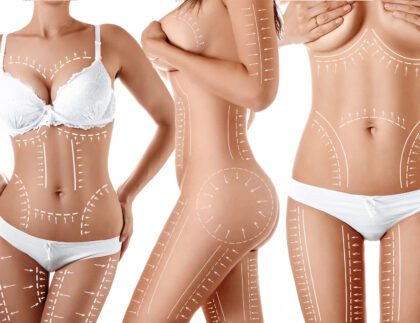
Wherever you are on your post surgery journey, whether that’s gearing up for plastic surgery or researching what to do now that you’re post-op, educating yourself properly on the dos and don’ts of post-op care is key to healing and ensuring you get your desired results.
Part of this journey is understanding the role swelling plays in your recovery. While it might be a little alarming at first, swelling post surgery is totally normal. It’s actually how your body starts the healing process. What isn’t normal is swelling that doesn’t go away, hardens, and then turns into lumps and bumps (fibrosis). Fortunately, you can prevent fibrosis and also get rid of it too (which we will dive into below).
There’s so much conflicting or incorrect information on the internet about what to do to reduce swelling post surgery, which is what we want to set straight. After 7+ years of doing manual lymphatic drainage massage and helping hundreds of clients heal post-surgery, we want to share our tips on how to reduce swelling post-op with you so you have access to the information you need to heal.
Understanding Swelling and What Causes It
Swelling happens after any surgery; it’s your body’s natural healing response. Swelling isn’t necessarily a concern post-op, however, you should keep an eye out for excessive swelling, swelling that doesn’t go down, or swelling that becomes thick and hardens.
There are many reasons your body creates swelling and inflammation, but the main reason is to heal an injury, like surgery. This “fluid” is lymphatic fluid, which is made up of white blood cells, fats, proteins, water and it's the healing juices your body needs post-op. Your body has a built in system called your lymphatic system, that’s responsible for processing swelling out of the body through your urine every day.
Swelling becomes an issue when extra fluid (swelling), which your body brings in to heal your tissue, gets trapped under the skin. One of the best ways to reduce swelling after surgery is always manual lymphatic drainage massage. These massages work with the lymphatic system to speed up absorption of the excess swelling, preventing it from becoming trapped in the healing tissue, stagnant and hardening which causes the lumps and bumps (fibrosis) and pain.
The 2 most important questions to ask are: how long should swelling last after surgery and the best ways to reduce swelling after surgery, to avoid issues with your healing the best way to ensure you get the results you paid for.
Preparing for Surgery: Steps to Reduce Swelling
We can’t stress how important educating yourself and becoming your best post-op advocate is during this time. Your recovery is your responsibility, so you'll want to learn the following:
- The role the lymphatic system plays in healing and reducing swelling.
- How much swelling to expect post-surgery.
- How manual lymphatic drainage massage supports your healing process.
- What to look for when choosing a manual lymphatic drainage therapist.
- What post-op garments and products to use.
If you’re concerned about excessive swelling and fibrosis, check out our online course which goes over everything you need to know about manual lymphatic drainage massage and how to prepare for post-op.
How Long Should Swelling Last After Surgery?
Generally, most people start to swell about 2 days post-surgery. There's something called the inflammation phase of wound healing, which is where your body brings in the swelling to help you heal. Typically around 4-6 weeks, your body should start to reabsorb the swelling.
Remember, the amount of surgery you have is going to play a role in the amount of swelling you’ll have and the time it may take for your swelling to be reabsorbed.
With manual lymphatic drainage massage and the proper compression garments, we can start to reduce the swelling immediately and not wait for it to hopefully start coming down at 4-6 weeks.
If you haven’t started your manual lymphatic drainage massages or you’re getting them now, what you want to watch out for is when your swelling doesn’t start to go down. That’s a sign that something is wrong. Maybe the massages you’re getting aren't real manual lymphatic drainage but “post-op massages” which are painful, fluid is being pushed out of your body, involves tools, machines or just rubbing you with oil and feel like a regular massage. Maybe your compression garment or faja doesn’t fit properly - it’s either too tight or not tight enough.
Swelling that fluctuates from day to day, surprise bruising and swelling post-surgery can happen when compression garments or fajas don’t fit well. A compression garment or faja that’s squeezing you in the wrong places ends up pushing fluid into other areas above and below where it sits on the body.
Squeezing yourself into the tightest garment possible cuts into the fragile tissue, causing another round of trauma, and your body starts to create more swelling to try and heal. Tighter is NOT better when it comes to garments, they're supposed to fit like a soft cast. If your garment is too loose, fluid will find any available space to fill and swell. Your garment shouldn't feel like sports compression.
So, if you’re swelling in an area where you didn’t get surgery done, your tissue isn't squishy, your swelling is firming up and not going down, this could be a sign your body’s lymphatic system needs your support or your compression garments don’t fit properly.
You need gentle, Vodder style, manual lymphatic drainage massages to stimulate the lymphatic system, help the body reabsorb excess swelling to be urinated out and proper fitting garments to support your tissue while it's healing.
What Supplies Do You Need Post-Surgery to Reduce Swelling?
Whether you’re recovering from a tummy tuck, Brazilian butt lift, liposuction, or another type of surgery, here are the supplies you actually need to help your body heal post surgery:
-Compression garments:
To support and close the tissue space where surgery was done so it doesn't fill up with excess swelling.
-Medical Grade, Machine Washable, Lipo foams:
Not all foams are medical grade or work for post-op swelling, even if they say lipo foam. Our foams help turn fibrosis back to fluid for your body to urinate out, prevent garment burn and help moderate the compression in your garment. All the while providing stimulation to your lymphatic system to help process out the swelling.
-Medical compression garment and foam detergent:
You need detergent that can disinfect your garment and foams, while protecting the fabric of your supplies so they last your entire recovery. Store bought detergents have chemicals and fragrances that break down the material of your garment and foams, irritate your incisions and skin while healing, cause rashes, and they arn’t meant to disinfect the fibers of your garment properly.
-Skin care, including arnica cream, post-surgery silver gel healing ointment wound care, and post-surgery body wash.
Your skin is often overlooked in the surgery recovery process. It's trapped in the garment, dry, itchy and flaky, driving you nuts!
The antibacterial soaps are doing more harm than good to your skin if used for too long. Switching to a post-op gentle cleanser to treat your skin can stop the flaking, peeling and cracking of your skin and incisions.
Not all arnica cream is strong enough to heal the trauma post-op. You need an extra strength arnica cream that's more than just arnica.
Arnica is not the only herb that’s important for healing after surgery. Herbs like echinacea, calendula, lemongrass and many others included in out cream, help bring feeling back to the skin, provide relief from inflammation as well as being a topical analgesia, which means it stops pain at the skin by healing the tissue, not just covering it up like pain meds do.
Wound care is something that's often down played post-op. You often will get told to use neosporin, bacitracin or vaseline on your incisions, causing them to be wet and have trouble healing. Scars become dark and very noticeable when as the incision is healing, the skin around the actual cut gets abused from being dry, cracked and peeling. You need a wound care ointment that creates a protective barrier, works to heal your incision while not being too wet or dry.
Your Road to Post-Surgery Recovery: How to Set Yourself Up for Success
Set yourself up for success post-surgery by following these steps to help your body heal, reduce swelling, and love your post-op results:
- Learn how manual lymphatic drainage massage works and how to find someone certified in real manual lymphatic drainage, not just post-op.
- Use proper garments and post-op products.
- Know what the signs are that your body isn't healing right and what to do about it.
- Team up with a plastic surgery recovery specialist to help navigate and set up a post-op recovery plan for your compression garments, fixing/ avoiding fibrosis, managing/reducing your swelling, post-op diet and all other post-op challenges.
For additional support, check out our online course on manual lymphatic drainage which covers all of these bullet points and more!



